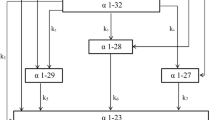Summary
The haemoglobin from slaughter house blood is a waste produce due to the colour and off-flavour. Many methods for the decolorization of haemoglobin have been described; they are often unsatisfactory for operation on an industrial scale. This study demonstrates the use of aluminium oxide in order to decolorize a peptic hydrolysate of bovine blood. Peptides were obtained by this method both on the laboratory and pilot plant scale.
Résumé
L'hémoglobine provenant du sang d'abattoir est actuellement considérée comme un déchet, ceci à cause de sa couleur et de son odeur désagréable. Plusieurs méthodes de décoloration de l'hémoglobine ont été décrites; elles ne sont souvent applicables à l'échelle industrielle. Ce travail montre l'utilisation de l'alumine pour décolorer un hydrolysat pepsique de sang bovin. Des peptides ont été obtenus par cette méthode à la fois au laboratoire et au stade pilote.
Resumen
La hemoglobina obtenida a partir de sangre de matadero es un producto no aprovechable debido a su color y mal olor. Se han descrito muchos métodos para decolarar la hemoglobina, pero estos no son generalmente adecuados para su utilización industrial. En este estudio se demuestra el uso del óxido de aluminio para la decoloración de un hidrolizado peptídico de sangre bovina. Los péptidos se obtuvieron tanto a escala de laboratorio como a escala semiindustrial en una planta piloto.
Similar content being viewed by others
References
Anon 1979 Novo Industrie A/S. Brevet d'Invention. Procédé de production d'une matière à base de sang pour produit alimentaire et matière ainsi produite. HAR/DRZ 0081-79-52-8, 5/2/79, France 53372/GL.
Antonini, E. &Brunori, M. 1971 Hemoglobin and myoglobin in their reactions with ligands. InResearch Monographs, Frontiers of Biology, ed. Neuberger & Tatum,21, 123–125. Amsterdam: North Holland.
Caldironi, H.A. &Okerman, H.W. 1982 Incorporation of blood proteins into sausage.Journal of Food Science 47, 405–408.
Carantino, S. 1983 Additifs et auxiliaires technologiques.Alimentation 107, 57–66.
Doi, E., Daisuke, S. &Teruyoshi, M. 1981 Modified colorimetric ninhydrin methods for peptidase assay.Analytical Biochemistry 118, 173–184.
Light, A. 1972 Leucine aminopeptidase in sequence determination of peptides.Methods in Enzymology XXV 253–262.
Oord, A.H.A. &Wesdorp, J.J. 1979 Decolouration of slaughterhouse blood by treatment with hydrogen peroxide.Proceedings of the European Meeting of Meat Research Workers 25, 825–828.
Regnier, J. 1983 Décoloration enzymatique du cruor d'abattoirs.Revue technique de la Viande et de l'Alimentation 11, 29–35.
Sato, Y., Hayakawa, S. &Hayakawa, M. 1981 Preparation of blood globin through carboxymethyl cellulose chromatography.Journal of Food Technology 16, 81–91.
Stachowicz, K.J., Eriksson, C.E. &Tjelle, S. 1977 Enzymatic hydrolysis of ox-blood hemoglobin,American Chemical Society, Symposium Series,47, 295–303.




